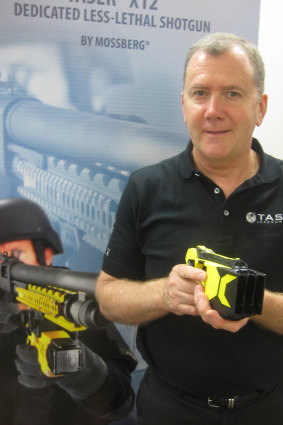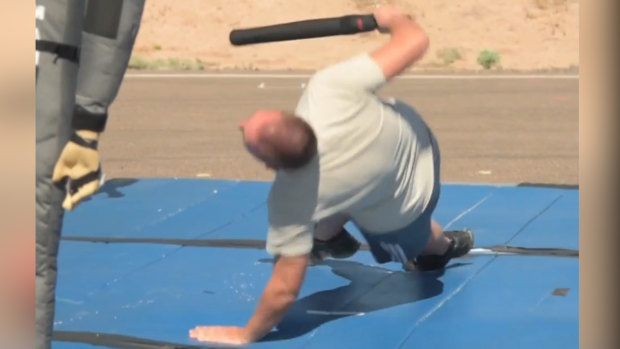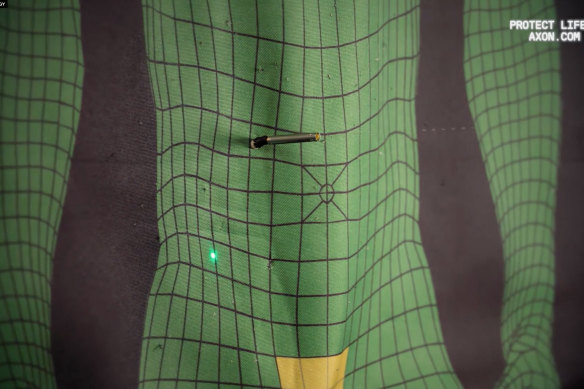Save articles for later
Add articles to your saved list and come back to them any time.
George Hateley knows a lot about Tasering. So much that he’s tried it 13 times and even Tasered his daughter.
Hateley, who is a former special operations tactical officer who advocated for Tasers to come to Australia, explains what happens when a person is Tasered.
“It’s like going to a gym session,” he said. It creates a feeling of exhilaration as the body will be hit with 50,000 volts of electricity, 19 times a second for five seconds.
In that time, officers usually grab and detain the person to prevent them from getting hurt.
The use of Tasering by police has been brought under scrutiny after the death of Clare Nowland, 95, a week after she was Tasered by a police officer at a care home in Cooma.
“There has been plenty of occasions where people are completely off their head with drugs, alcohol … and a Taser will incapacitate them because it attacks the skeletal muscles in the body,” Hateley said.
“As soon as that Tasering stops, they’re up and about in most cases.”
Is it painful?
“It’s the worst pain I’ve ever experienced. I’ve been OC [pepper] sprayed, I’ve been hit with all sorts of things, I’ve been shot, I’ve been stabbed and with Taser it’s just excruciating,” Hateley said.
George Hately with a Taser in 2009.Credit: AAP
“[The first time] I didn’t scream, I got a real shock and I virtually jumped up in the air and landed on my bum.”
While Hateley said it was “excruciating pain”, Tasering is often used on people in a heightened state of arousal who don’t feel the pain as intensely.
“When exposed to a person that might be [in a] rage, alcohol, drug or mentally affected, pain tolerance doesn’t mean a lot to those people,” he said.
How do they work?
When deployed, the handheld device releases copper wires with two darts which has “basically a fishhook” on the end. “When it hits a person wearing clothes, it’ll hook into their clothing or hook into their skin and it’s designed to only go a certain depth,” Hateley said.
A well-trained officer aims to hit the central body mass with one dart above and below the belt.
“Instead of a loud crackling sound, which is a normal sound of a Taser, you’ll hear a muffled sound and that means it’s a good deployment, that means the electricity is gone inside the subject’s body,” he said.
Why do police choose to use them?
When used appropriately, Tasering is an alternative to lethal force to protect police officers, which Hateley said was crucial for their safety.
“Police officers need an alternative to lethal force. You don’t want them shooting everyone, but you certainly don’t want them Tasering 95-year-old ladies either,” he said.
Training is key. Hateley said a well-trained officer has to consider the risks a person faces when they will likely fall from being Tasered and the position of where the weapon is deployed, which is also outlined by the NSW Police Force.
A man falls to ground after being Tasered in a test.Credit: Axon
“There’s a lot of things to consider in a nanosecond but, under stress, a police officer is going to revert to his training,” Hateley said.
The Taser specialist said he used his own daughter as an example when he was training 45 special force police officers from Australia and New Zealand. “I prepared her mentally, I said ‘do not scream, there’s 45 special forces people in this room’ … so she volunteered first. She didn’t make a sound,” he said.
“The 45 blokes that got Tasered after that all squealed and some screamed.”
When can’t police use Tasers?
Police cannot use Tasers on someone at risk of significant secondary injuries, such as someone likely to fall from a height and injure their head. Tasers cannot be used to rouse an intoxicated person or on someone who is refusing to move on from an area and who isn’t threatening police.
They also cannot be used for crowd control, on people wielding guns or against mental health patients “solely to make them comply”. (About a third of incidents where police have used Tasers in NSW have involved people with mental health conditions.)
Unless in exceptional circumstances, police guidelines hold that Tasers shouldn’t be used against people who are elderly, handcuffed, pregnant, disabled or have a small body mass (including children). The same rules apply for people who are running away or driving.
Police are only supposed to fire a Taser to protect human life or protect themselves from violent confrontation, risk of bodily harm and dangerous animals.
Can they affect the heart?
While 50,000 volts sounds severe, it’s the amperage – or force of an electric current – that’s deadly in an electric shock. The Tasers used by NSW Police have a current of about 2 milliamps, which is enough to administer severe pain and muscle contractions but not enough to kill.
In comparison, Australian wall sockets carry 240 volts and 10 amps (or 10,000 milliamps).
Death becomes possible between 50 to 150 milliamps. That’s the range where a shock could cause ventricular fibrillation, an irregular heartbeat that stops the heart from pumping enough blood that can be deadly.
A taser barb fired into a target.Credit: Axon
The body’s muscles are controlled by electrical impulses, which is why an electric shock – such as one from a Taser – triggers muscle contractions and “stuns” a target. An electric shock can interrupt the muscle contractions of the heart’s ventricles and cause dangerous arrhythmia.
The shock of a Taser is usually too low to drastically affect the heart. Research suggests Taser-induced ventricular fibrillation is possible, particularly for people with underlying heart problems, but the risk is extremely low.
A review of the risk of Tasers by Australian emergency doctors noted that people who have a low body weight and are Tasered in the chest may have a higher risk of ventricular fibrillation.
What are the other health risks?
Injuries inflicted by the actual barbs are more widely reported. The doctors said that in at least 1 per cent of cases, the Taser’s barbs hit people in the face and there are numerous instances of eye injuries and skin lacerations.
Other researchers wrote in the Medical Journal of Australia that “the mechanical impact of the barbs, combined with the subsequent voltage released, represents a considerable hazard to eyes, genitalia and large blood vessels in the neck”.
Researchers have also investigated whether Tasers are implicated in deaths caused by “excited delirium”, an acute state of agitation and stress often experienced by people who have used hard drugs or have a psychiatric illness.
Roberto Curti died in Sydney in 2012 after being Tasered 14 times.
Some research has suggested subjecting someone who is experiencing excited delirium to an immense amount of pain via a Taser can worsen the syndrome and increase the risk of death, but the results are inconclusive.
The NSW police guidelines for Taser use warn about the risks of positional asphyxia – where the position of someone’s body interferes with their ability to breathe – which is common among people experiencing delirium or mania.
Barbs that pierce someone’s face, eyes, neck, bones, groin or breast must be removed by paramedics or doctors, and an ambulance has to be called every time someone is Tasered.
The Morning Edition newsletter is our guide to the day’s most important and interesting stories, analysis and insights. Sign up here.
Most Viewed in National
From our partners
Source: Read Full Article




